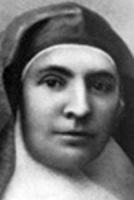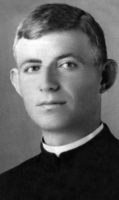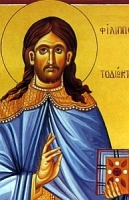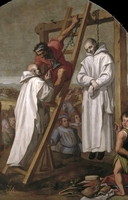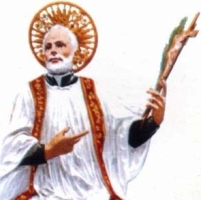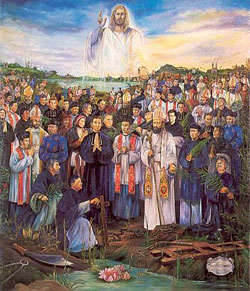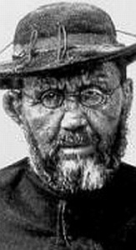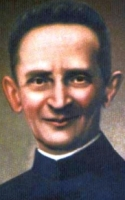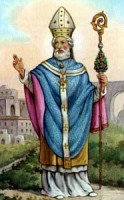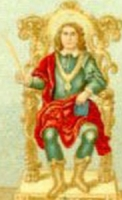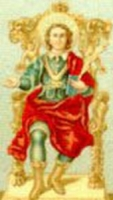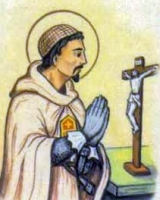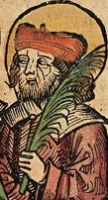Bl. Francis Patrizzi
Feastday: May 12
Death: 1328
Italian member of the Servite Order, also called Patrizi. Born in Siena, he joined the Servites after listening to a moving sermon delivered by Blessed Ambrose Sansedoni, whose eloquence was the final inspiration for Francis to enter the religious life. St. Philip Benizi himself received Francis into the Servites. As a Servite. Francis distinguished himself with his holiness and his remarkable ability to solve crises of various kinds through his personal mediation.
St. Leopold Mandic
Feastday: May 12
Birth: 1866
Death: 1942
Image of St. Leopold MandicSaint Leopold Bogdan Mandi? was born on May 12, 1866 and died on June 30, 1942. He was an ethnic Croat born in Herceg Novi, in Boka Kotorska (modern-day Montenegro), and died in Padua, Italy. Physically malformed and delicate, having a height of only 1.35m, with clumsy walk and stuttering, he developed tremendous spiritual strength. His feast is celebrated May 12.
Although he wanted to be a missionary in Eastern Europe, he spent almost all of his adult life in Italy, and lived in Padua from 1906 until the end of his life. He spent also one year in Italian prison during WWI, since he did not want to renounce his Croatian nationality. He also dreamed unceasingly about reuniting the Catholic and Orthodox churches and going to the Orient. He became known as Apostle of Confession and Apostle of Unity. He made a famous prayer that is the forerunner of today's Ecumenism.
Bogdan Mandi? was the twelfth child of Dragica Carevi? and Petar Antun Mandi?, owner of an Adriatic fishing fleet; they came from village of Zaku?ac (hinterland of city of Omiš, 28 km from Split). The origins of his family are noble; they came from Vrhbosna province in Bosnia.
He suffered from disabilities that would plague his speech and stature. The family eventually lost most of its wealth, and became more sympathetic to those who suffered in similar situations. In November of 1882 while he was 16, Bogdan went to Udine to enter the seminary of the Venetian Capuchins, and accepted the name "Leopold". Two years later he was put in the Bassano del Grappa friary, where he took the name Leopold. His first profession of vows were made a year later in May and a profession of perpetual vows 4 years latter in 1888.
In the mid-1880s, Croatian Bishop Josip Juraj Strossmayer began a movement which focused on unity and consecration of the cathedral of ?akovo and Srijem, a movement in which Leopold took interest in. On September 20, 1890, Leopold was ordained to the presbyterate at Venice at the age of 24.
Refusing to renounce his Croatian nationality during World War I, Leopold was forced to go to southern Italy. All this time Leopold held a hope that he would be able to return to his homeland and preach among his people, a feat that would be inhibited by his disabilities. On top of his physical deformities, he also suffered from stomach ailments, poor eyesight, and arthritis. Unsurprisingly, the Capuchin ministers declined these attempts due to his health.
While in Italy, Leopold's main vocation was confessions, which he did for 34 years. The Capuchin brothers often criticized Leopold for his approach to confession, calling him too lenient and compassionate. Leopold's compassion showed that he was more understanding and sympathetic to the people that came to him, and would treat them with great sensitivity. He was an outspoken on issues with children, and being pro-life and especially fond of expectant mothers and young children. He did great work in setting up orphanages for children without parents.
Leopold also had a deep devotion to the Virgin Mary who he referred to as "my holy boss". He was known to pray the rosary quite often, and celebrated the eucharist daily at the side altar in the Little Office of the Virgin Mary. He would then visit the sick in nursing homes, hospitals and homes all over Padua. He visited the Capuchin infirmary to comfort the sick friars, giving them words of advice and reminding them to have faith.
Leopold suffererd from esophagus cancer, which would ultimately lead to his death at age 76. On July 30, 1942, while preparing for the liturgy, he collapsed on the floor. He was then brought to his cell, where he was given the last rites. Friars that had gathered at his bed sang "Salve Regina," and when they got to the words, "O clement, O loving, O sweet Virgin Mary," Leopold died.
During the bombing of World War II the church and part of the friary where Leopold lived were demolished, but Leopold's cell and confessional were left unharmed. Leopold had predicted this before his death, saying, "The church and the friary will be hit by the bombs, but not this little cell. Here God exercised so much mercy for people, it must remain as a monument to God's goodness." Paul VI beatified Leopold on May 2, 1976. He was canonized by John Paul II during the Synod of Bishops on October 16, 1983. Leopold is hailed as the "Apostle of Unity."
St. Flavia Domitilla
Feastday: May 12
Death: 2nd century
Martyr with Euphrosyna and Theodora. She was related to Emperors Domitian and Titus and was a great-niece of St. Flavius Clemens. She was martyred with her two foster sisters. This cult was suppressed in 1969.
Saint Epiphanius of Salamis
Also known as
• Epiphanius of Constanzo
• Epiphanius of Constantia
• Epiphanius of Cyprus
• Epiphanus, Epifanio
• Oracle of Palestine
Profile
A Hellenized Jew, and convert to Christianity. Fluent in five languages, and extensively studied in theology and the classics. Monk in several communities in Egypt, returning to Palestine in 333. Priest. As a young man he founded a monastery at Eleutheropolis (Beth-Saddouk), and lived there as a monk for 30 years, serving as its superior. Bishop of Constantia and Metropolitan of Cyprus in 367 while remaining in his monastery. Fought Origenism and Arianism. Friend of Saint Jerome, but opponent of Saint John Chrystotom whom he found insufficiently orthodox. Brilliant speaker, he sometimes let his ability go to his head, and his confrontational approach got in the way of persuading his opponents. Doctor of the Church. He was an authority on Marian devotions, and his writings include a Bible dictionary, and The Medicine Box, a huge work which cataloged and refuted eighty heresies of his day.
Born
315 at Besanduk, near Eleutheropolis, Judea
Died
403 at sea of natural causes
Blessed Imelda Lambertini
Profile
Daughter of Count Egano Lambertini of Bologna and Castora Galuzzi. While still a child, she put together a little oratory in her house, and spent much time there in prayer. She felt drawn to religious life, and planned to become a nun. Student at Dominican Convent of Valdi-Pietra in Bologna, Italy, partly in preparation for religious life. Had a great devotion to Saint Agnes of Rome, of whom she may have had visions, to Mary as Queen of Angels, and to the Holy Eucharist. On 12 May 1333 she miraculously received her First Communion, and immediately after died in an ecstasy of love and joy.
Born
1322 at Bologna, Italy
Died
• Feast of the Ascension, 12 May 1333 Bologna, Italy
• relics at the Church of Saint Sigismund in Bologna
Beatified
20 December 1826 by Pope Leo XII (cultus confirmed)
Patronage
first communicants (named by Pope Saint Pius X)
Saint Pancras of Rome
புனிதர் பங்க்ராஸ்
(St. Pancras of Rome)
மறைசாட்சி:
(Martyr)
பிறப்பு: கி.பி. 289
சின்னாடா
(Synnada)
இறப்பு: மே 12, 303-304 (வயது 14)
ஏற்கும் சமயம்:
ரோமன் கத்தோலிக்க திருச்சபை
(Roman Catholic Church)
கிழக்கு மரபுவழி திருச்சபை
(Eastern Orthodox Church)
முக்கிய திருத்தலம்:
சேன் பங்க்ராசியோ, ரோம், இத்தாலி
(San Pancrazio, Rome, Italy)
பாதுகாவல்:
குழந்தைகள், வேலைகள், ஆரோக்கியம் மற்றும் தசைப்பிடிப்பு, பொய் சாட்சிகள், தலைவலி மற்றும் பொய்யுரை ஆகியவற்றுக்கு எதிராக
நினைவுத் திருநாள்: மே 12
புனிதர் பங்க்ராஸ், கிறிஸ்தவ விசுவாசத்திற்கு மனம் மாறிய ரோம பிரஜையாவர். அவர், தாம் கொண்ட கிறிஸ்தவ விசுவாசத்திற்காக தமது பதினான்கு வயதிலேயே தலை துண்டிக்கப்பட்டு மறை சாட்சியாக மரித்தார்.
புனிதர் பங்க்ராஸ், "சின்னாடா" (Synnada) எனும் நகரின் அருகே ரோம பிரஜைகளான பெற்றோருக்கு பிறந்தவர் ஆவார். இவரது தாயார் "சிரியாடா" (Cyriada) இவர் பிறந்தபோதே மரித்துப் போனார். இவரது தந்தை "க்ளயோனியஸ்" (Cleonius) இவருக்கு எட்டு வயதாகையில் மரித்தார். பங்க்ராஸின் மாமா "டயோனிசியஸ்" (Dionysius) இவரை வளர்த்தார்.
இருவரும் ரோமிலுள்ள "செலியியன்" (Caelian Hill) மலையில் வசிப்பதற்காக புலம்பெயர்ந்தனர். கிறிஸ்தவ மதத்திற்கு மனம் மாறிய இருவரும் விசுவாசம் மிக்கவர்களாக வாழ்ந்தனர். பங்க்ராஸ் தமது விசுவாசத்தில் தீவிர வைராக்கியம் கொண்டிருந்தார்.
ரோமப் பேரரசன் "டயக்ளீசியன்" (Emperor Diocletian) காலத்தில் சுமார் கி.பி. 303ம் வருடம் கிறிஸ்தவர்களை துன்புறுத்த தொடங்கினர். பங்க்ராஸும் அவரது மாமனும் கிறிஸ்தவ விசுவாசிகள் என்பதை அறிந்த அதிகாரிகள், இருவரையும் கொண்டுவந்து, ரோமானிய கடவுளர்களுக்கு தியாகம் ஒப்புவிக்க வற்புறுத்தினர். அவர்களின் விசுவாசம் கண்ட பேரரசன் "டயக்ளீசியன்", அவர்களுக்கு தேவையான செல்வமும், வசதிகளும் செய்து தருவதாக வாக்குறுதி அளித்தான். ஆனால், தமது விசுவாசத்தில் உறுதியாய் இருந்த அவர்களிருவரும் தீர்க்கமாக மறுத்துவிடவே, ஆத்திரமுற்ற பேரரசன், அவர்களிருவரையும் தலையை வெட்டி கொலை செய்ய உத்தரவிட்டான்.
கிறிஸ்துவின் மீது மிகுந்த பக்திகொண்ட பங்க்ராஸ், தனது 14ம் வயதிலேயே கொடிய சித்ரவதைக்கும், சாவுக்கும் உள்ளானார்.
ஐந்தாம் நூற்றாண்டில் இருந்தே பங்க்ராசின் பக்தி இருந்து வருகின்றது. இவரது பெயரில் அர்ப்பணிக்கப்பட்ட பேராலயம் (Basilica of Saint Pancras), திருத்தந்தை சைமச்சஸ் (Pope Symmachus) அவர்களால், (கி.பி. 498-514) பங்க்ராஸ் அடக்கம் செய்யப்பட்டுள்ள இடத்தில் கட்டப்பட்டது. இளைஞர் பங்க்ராஸ் இன்று எந்த அளவுக்கு சிறப்புப் பெற்றவரெனில், லண்டனில் புனித பங்க்ராஸ் பெயரில் தொடர்வண்டி நிலையம் ஒன்று இன்றும் காட்சியளிக்கிறது. புனிதர் பெரிய கிரகோரி (Pope Gregory the Great) மறைபரப்பு பணிக்கென இங்கிலாந்து சென்றபோது, இப்புனிதர் பெயரால் ஆசீர்வாதப்பர் சபைத் துறவிகளுக்கு துறவு மடம் கட்டினார். அப்போது இச்சபையை சேர்ந்த துறவியும் ஆயருமான அகஸ்டின் (Augustine) பதவிக்கு வந்தார். அப்போது அவர் அந்த நாட்டில் எழுப்பிய முதல் ஆலயத்திற்கு புனிதர் பங்க்ராஸ் பெயரை சூட்டினார்.
கர்தினால் வைஸ்மன் "பபியோலா" என்ற புனைப்பெயரில் எழுதிய பங்க்ராஸின் வாழ்க்கை வரலாற்றை முன்வைத்து எழுதினார். பங்க்ராஸின் வாழ்க்கை வரலாற்றில் நமக்கு கிடைக்கும் தகவல் மிக மிக குறைந்ததே. ஆயினும், விசுவாசத்தில் வீரச்சாவு வரைக்கும் அவர் காட்டிய பற்றுறுதி, அன்று முதல் இன்று வரை ஓர் உயர்ந்த எடுத்துக்காட்டாக உள்ளது.
Also known as
Pancritas, Pancratius, Pancrazio, Pancracio, Pancrace
Profile
Fourteen-year-old orphan, brought to Rome by his uncle, Saint Dionysius. Convert to Christianity. Martyred with Saint Nereus, Saint Achilleus, and Saint Domitilla for publicly proclaiming his faith. Pope Saint Vitalian sent his relics from the cemetery of Calepodius in Rome to the British Isles as part of the evangelization of England, so they would have relics of the Church at large, and to install in altars in new churches. Saint Augustine of Canterbury dedicated the first church in England to Saint Pancras, and subsequent churches throughout England are similarly named for him.
Born
c.290 at Phrygia
Died
• beheaded c.304 on the Via Aurelia, Rome, Italy
• relics interred in the Saint Pancras church, Rome, but were destroyed in 1798
• his head is still in the basilica of Saint John Lateran
Patronage
• against cramps
• against false witness or perjury
• against headaches
• children
• oaths, treaties
• diocese of Albano, Italy
• 27 cities in Germany and Italy
Blessed Álvaro del Portillo Díez de Sollano
Profile
One of eight children. Joined Opus Dei in 1935. Engineering student. Member of the Saint Vicent de Paul Society, and taught catechism to children in in poor neighbourhoods where the Society worked. Priest, ordained on 25 June 1944 in Madrid, Spain. Assigned to work in Rome, Italy in 1946. Bishop of the Personal Prelature of the Holy Cross and Opus Dei on 28 November 1982. Titular bishop of Vita on 7 December 1990.
Born
11 March 1914 in Madrid, Spain
Died
23 March 1994 in Rome, Italy of natural causes
Beatified
• 27 September 2014 by Pope Francis
• beatification recognition celebrated in Madrid, Spain
• the beatification miracle involves the August 2003 healing of Chilean newborn Jose Ignacio Ureta Wilson; just a few days old, the boy suffered a 30-minute period of cardiac arrest and a major hemorrhage; his medical team thought the boy had died, but his parents prayed for healing through the intercession of the bishop, and Jose now lives a normal life
Saint Richrudis of Marchiennes
Also known as
Rictrude, Rictrudis
Profile
Born to the nobility, the daughter of Ernold. Married to the Frankish nobleman Saint Adalbald of Ostrevant. Her family objected to Adalbald's military incursions into their region, and endlessly opposed the marriage. Mother of four - Saint Eusebia of Hamage, Saint Clotsindis of Marchiennes, Saint Adalsindis of Hamay, and Saint Maurontius. The couple dedicated themselves and their fortunes to care for the poor and to religious projects including founding a Benedictine double monastery at Marchiennes, Flanders, Belgium. After Adalbald was murdered, she was pressured by the royal court to remarry. She refused, and with the help of her friend, Saint Amandus, she became a Benedictine nun at the Marchiennes monastery. Abbess there for forty years. Three of her children, Adalsindis, Clotsindis, and Maurontius, lived there in religious life during her time.
Born
612 in Gascony, France
Died
• 12 May 687 in Marchiennes, Belgium of natural causes
• relics translated to Paris, France
• relics destroyed in 1793 during the French Revolution
Saint Candida Maria de Jesus Cipitria y Barriola
Also known as
Juana Josefa Cipitria y Barriola
Profile
Oldest of seven children born to Juan Miguel Cipitria and María Jesús Barriola. The family were weavers, and Juana learned the craft as a child. At age 18 she left home to work as a maid to a family in Burgos, Spain. Juana early felt a call to religious life, and on 8 December 1871 she founded the Congregation of the Daughters of Jesus to work for a Christian upbringing of children, and to improve the condition of woman in Salamanca, Spain. She took the name Mother Candida Maria de Jesus, and the Congregation received papal approval from Pope Leo XIII on 30 July 1901. Mother Candida based her spirituality on the Spiritual Exercises of Saint Ignatius of Loyola.
Born
31 May 1845 in Andoáin, Guipúzcoa, Spain as Juana Josefa Cipitria y Barriola
Died
9 August 1912 in Salamanca, Spain of natural causes
Canonized
17 October 2010 by Pope Benedict XVI
Blessed Jane of Portugal
Also known as
Joan, Joana, Johanna
Profile
Princess, the daughter of Elizabeth and King Alphonsus V of Portugal. Entered a Dominican convent at Aveiro, Portual in 1473. The royal family objected to her taking vows because she might need to marry to insure the continuity of the royal bloodline. She agreed, fended off arranged marriages, and did not take vows until 1485 when the succession was secured.
Born
16 February 1452 at Lisbon, Portugal
Died
12 May 1490 in Aveiro, Portugal of natural causes
Beatified
31 December 1692 by Pope Innocent XII (cultus confirmed)
Patronage
diocese of Aveiro, Portugal
Saint Crispoldus
Also known as
Chrysopolitus, Crispoldo, Crispolito, Crispolto, Crispoltus, Cyspolitus
Profile
Bishop of Bettona, Italy where he was known as a miracle worker. May have been bishop of Nocera, Italy, too. Arrested by order of prefect Asterius in the late 3rd-century persecutions of emperor Maximian, ordered to sacrifice to pagan gods, and then tortured and killed with another Christian, named Barontius, when he refused to do so. Martyr.
Some sources list him as one of 70 Disciples, and say that he was sent by Saint Peter the Apostle to evangelize in Italy in 58, but it’s hard to reconcile that with his death 250 years later.
Died
• c.300 in Bettona, Italy
• church built on the site of the execution
• his sister, Tutela, and 12 other women were arrested and martyred for trying to give the two men a Christian burial
• relics enshrined in an urn in a chapel in the church of Santa Maria Maggiore in Bettona in the 13th century
Patronage
Bettona, Italy
Saint Ethelhard of Canterbury
Also known as
• Aethelheard
• Aethilheard
• Aethelheard
• Aethilheard
• Ethelreard
Profile
Abbot, probably of Louth, Lincolnshire, England. May have been bishop of Winchester, England. Archbishop of Canterbury, England, consecrated on 21 July 793. Elected to the see at a time when Mercian King Offa was trying to weaken Canterbury's influence. Ethelhard had to flee from his see for a while, but when Cenwulf succeeded in Mercia, they worked together to restore the rights of Canterbury, a matter finally settled in 802. Had Offa succeeded, his policy would not only have affected the Church, it would have seriously slowed the unification of England. Ethelhard convened the synod of Clovesho in 803, which resulted in a requirement of a pledge obedience by new bishops to their superior.
Born
Louth, Lincolnshire, England
Died
• 12 May 805 at Canterbury, England of natural causes
• buried in the Canterbury cathedral
Saint Germanus of Constantinople
Profile
Son of a Senator Justinian of Constantinople. Priest. Bishop of Cyzicus. Attended the Synod of Constantinople in 712, and may have briefly agreed to the teaching of the Monothelite heresy supported by the emperor. Patriarch of Constantinople in 715. Opposed the Monothelites and then the iconoclasts and their mentor, emperor Leo the Isaurian. Forced to resign his position in 730 and sent into exile. Several of his writings, including homilies and hymns, have survived.
Born
c.640 in Constantinople
Died
12 May 733 at Platonium of natural causes
Saint Dominic de la Calzada
Also known as
• Dominic of the Causeway
• Dominic of Landeveien
• Domenico, Dominicus...
Profile
Feeling a call to religious life, Dominic tried to join the Benedictines at Valvanera, Spain, but was turned away. Hermit at Rioja, Spain at what is now the shrine La Calzada. To help pilgims to Compostela, Spain, and with the help of Saint John de Ortega he built by hand a causeway, bridge and hospice to make the travel easier. The location of his old hermitage is now a place of pilgrimage itself.
Born
Victoria, Biscay, Spain
Died
1109 of natural causes
Patronage
Spanish civil engineers
Blessed Lucien Galan
Also known as
Lucian, Luciano
Profile
Member of the Paris Foreign Missions Society. Priest. Missionary to China, working the Xichang, Sichuan area. Imprisoned for this work in November 1950, he was exiled and arrived in Hong Kong in January 1952. He was reassigned to a mountainous area of Laos in 1956; in February 1960 he replaced Blessed René Dubroux who had been murdered in 1959. Parish priest of Blessed Thomas Khampheuane Inthirath, he was taking the boy to catechist training when the two were murdered. Martyr.
Born
9 December 1921 in Golinhac, Aveyron, France
Died
shot on 12 May 1968 on the highway in Houey Makchan, Paksong, Champasak, Laos
Beatified
• 11 December 2016 by Pope Francis
• beatification recognition celebrated in Vientiane, Laos, presided by Cardinal Angelo Amato
Saint Casto of Calvi
Also known as
Castus
Profile
Priest. Missionary bishop. Miracle worker and healer.
Lured to a location near Aquaviva in central Italy with a challenge by pagan priests to prove the power of Christianity over that of idols, Casto and Saint Cassio of Sinuessa were seized, beaten and then thrown into a fire. When they were unharmed, the pagans claimed the two were using magic, pulled them from the fire, dragged them to a pagan temple, and ordered them to offer incense to an idol; when all the pagan priests were in the temple, it collapsed, killing them all and leaving Casto and Cassius untouched. The two bishops were then dragged to Sinuessa where they were stoned and murdered. Martyr.
Died
• stabbed with a sword at Sinuessa, Latium (in modern Italy)
• relics interred in the cathedral of Calvi, Italy
Saint Achilleus of Terracina
Also known as
Achille, Achilles, Acilius, Aquileus
Profile
Soldier in the imperial Roman army, and a member of the Praetorian Guard. Convert to Christianity, baptized by Saint Peter the Apostle. Exiled for his faith to the island of Pontia, he suffered with Saint Flavia Domitilla, and was martyred with his brother Saint Nereus.
Died
beheaded in 98 on the Ardeatine road outside Rome, Italy
Representation
• with Saint Flavia Domitilla if Terracina
• with Saint Nereus of Terracina
• palm of martyrdom
• holding a church in his hands
Saint Cassio of Sinuessa
Also known as
Cassius
Profile
Priest. Missionary bishop.
Lured to a location near Aquaviva in central Italy with a challenge by pagan priests to prove the power of Christianity over that of idols, Cassio and Saint Casto of Calvi were seized, beaten and then thrown into a fire. When they were unharmed, the pagans claimed the two were using magic, pulled them from the fire, dragged them to a pagan temple, and ordered them to offer incense to an idol; when all the pagan priests were in the temple, it collapsed, killing them all and leaving Cassio and Casto untouched. The two bishops were then dragged to Sinuessa where they were stoned and murdered. Martyr.
Died
stabbed with a sword at Sinuessa, Latium (in modern Italy)
Blessed Ejëll Deda
Profile
Studied with the Franciscans, and then at the Shkodrë Pontifical Seminary. Ordained on 24 February 1943 as a priest in the archdiocese of Shkodrë-Pult, Albania. Vicar of his archdiocese. Arrested on 12 November 1947 and sentenced to 10 years in prison during the anti–Christian persecutions of the Communist government. Martyr.
Born
22 February 1917 in Shkodrë, Albania
Died
12 May 1948 in prison in Shkodrë, Albania
Beatified
• 5 November 2016 by Pope Francis
• beatification celebrated at the Square of the Cathedral of Shën Shtjefnit, Shkodër, Albania, presided by Cardinal Angelo Amato
Blessed Dedë Malaj
Profile
Studied at the Pontifical French Seminary, and in Italy. Ordained on 20 December 1942 in Castel Gandolfo, Rome, Italy as a priest of the archdiocese of Shkodrë-Pult, Albania. Parish priest in the Buna Dajçit Coast area. Martyred in the Albanian Communist anti–Christian persecutions.
Born
16 November 1917 in Dushkul, Mali Shëngjinit, Lezhë, Albania
Died
shot on 12 May 1959 in Shkodrë, Albania
Beatified
• 5 November 2016 by Pope Francis
• beatification celebrated at the Square of the Cathedral of Shën Shtjefnit, Shkodër, Albania, presided by Cardinal Angelo Amato
Saint Modoald of Trier
Also known as
Modoaldo, Modoaldus, Modowald, Modowandus, Modwald, Romoald, Romoaldus
Profile
Born to the nobility. Brother of Saint Severa of Saint Gemma. Uncle of Saint Gertrude of Nivelles, Saint Begga of Ardenne and Saint Modesta of Trier. Counselor to King Dagobert I of the Franks. Bishop of Trier, Germany in 628. Attended the Council of Rheims. He spoke so strongly against the immorality of the Frankish royal court that King Dagobert was moved to personal conversion.
Born
Aquitaine, France
Died
• 640 in Trier, Germany of natural causes
• relics translated to Paderborn, Germany in 1107
Blessesd Juan de Segalars
Profile
Joined the Mercedarians in Barcelona, Spain. Prior of his house. General procurator of the Mercedarians in 1439. Attended the Council of Basel in 1439-1440. He several times visited the Vatican for consultation with the pope. Travelled to Tunis in North Africa in 1447 to ransom Christians enslaved by Muslims; he survived, but the treasure he carried was lost, and he was unable to free the slaves.
Born
Barcelona, Spain
Died
• 24 October 1466 in Barcelona, Spain of natural causes
• buried near the main altar of the church of the Mercedarian convent in Barcelona
Blessed Thomas Khampheuane Inthirath
Profile
Teenaged layman in the apostolic vicariate of Pakse (in modern Laos). His father had served as catechist for his parish, and Thomas was studying to become a catechist himself. Martyr.
Born
May 1952 in Nong Sim, Champasak, Laos
Died
shot on 12 May 1968 om the highway in Houey Makchan, Paksong, Champasak, Laos
Beatified
• 11 December 2016 by Pope Francis
• beatification recognition celebrated in Vientiane, Laos, presided by Cardinal Angelo Amato
Saint Philip of Agira
Also known as
• Apostle of the Sicilians
• Philip of Aggira
• Philip of Agirone
• Philip of Agirya
• Philip of Argira
Profile
First Christian missionary to Sicily. Exorcist. Many stories grew up around him, all apparently legend.
Born
c.396 in Thrace
Died
c.453 in Agira, Sicily, Italy of natural causes
Patronage
• Agira, Sicily, Italy
• Zebbug, Malta
Saint Nereus of Terracina
12-may/
Profile
Soldier in the imperial Roman army, and a member of the Praetorian Guard. Convert to Christianity, baptized by Saint Peter the Apostle. Exiled for his faith to the island of Pontia, he suffered with Saint Flavia Domitilla, and was martyred with his brother Saint Achilleus.
Died
beheaded in 98 on the Ardeatine road outside Rome, Italy
Saint Erc Nasca of Tullylish
Also known as
• Erc Nasca de Talach-leis
• Erc Nasca of Tilaig Leis
• Erc Nasca of Tulach-lis
• Erc Nasca of Ui Eachach Uladh
• Erc Nasc, Earc, Ercus, Herc
Profile
Confessor of the faith in Ireland. His memorial is found on several calendars and martyrologies, but the details of his life have been lost.
Saint Diomma of Kildimo
Also known as
Diamma, Dimma, Dioma
Profile
Son of Cass. Spiritual teacher of Saint Declan of Ardmore and other Irish evangelists.
Born
Irish
Died
5th century of natural causes
Patronage
Kildimo, County Limerick, Ireland
Saint Dionysius of Asia
Profile
Uncle and guardian of Saint Pancras. In Rome, Italy the two converted to Christianity. Arrested for his faith during the persecutions of Diocletian, he died in a Roman prison. Martyr.
Born
Asia Minor
Died
304 in Rome, Italy
Saint Cyril of Galatz
Also known as
Cyril of Axiopolis
Profile
Martyred with six companion Christians. We know nothing else about them.
Died
3rd century Galatz (Axiopolis), Mesia (in modern Romania)
Saint Euphrosyna of Teracina
Profile
Foster sister of Saint Flavia Domitilla and Saint Theodora of Terracina. Exiled and then martyred with her.
Died
2nd-century Terracina, Italy
Saint Theodora of Terracina
Profile
Foster sister of Saint Flavia Domitilla and Saint Euphrosyna of Terracina. Exiled and then martyred with her.
Died
2nd-century Terracina, Italy
Saint Ephrem of Jerusalem
Also known as
Efrem
Profile
13th bishop of Jerusalem at the time of emperor Hadrian.
Saint Palladius of Rome
Profile
Martyred at age 14 in the persecutions of Diocletian.
Died
c.304 at Rome, Italy








